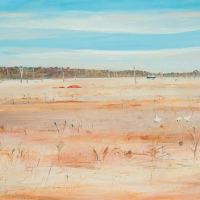47. ARTHUR BOYD

Arthur Boyds first Wimmera landscapes were conceived in 1948-49, when he and the poet Jack Stephenson embarked on a painting trip to Horsham. Considered the regional capital of Victorias Wimmera area, Horsham is set to the north of The Grampians on the banks of the Wimmera River, approximately 300 kilometres north-west of Melbourne. With its flat, sun-parched paddocks and endless horizons, the wheat farming district presented Boyd with such a stark contrast to the verdant, undulating terrain of Berwick and Harkaway (which had inspired his series of Brueghelesque idylls), the artist found he needed to develop a new visual vocabulary in order to capture the landscape. Barry Pearce, in his introduction to The Art Gallery of New South Wales 1993 retrospective exhibition catalogue, describes Boyds discovery of the area:
In the summer of 1948-49 he accompanied Jack Stephenson to Horsham where he painted landscapes near the border of the Wimmera River, and was to return on several painting trips to the far north-west of the state over the next few years. He discovered there the hint of something that had drawn other painters of his generation; a subject tentatively recorded by a few artists of the nineteenth century, and touched on by even fewer in the twentieth: the empty spaces of the great interior.1
After a period of focus on ceramics, the mid-late fifties saw a revival of Boyds landscape painting. These landscapes were painted in conjunction with his landmark series Love, Marriage and Death of a Half-Caste 1954-59, and demonstrate a great duality in Boyds art. Discussion of this synchronous multiplicity of style and subject matter is customary in all writings on Arthur Boyd; quite simply he was unfalteringly good at it. Ursula Hoff remarked in the epilogue to her 1986 study of Arthur Boyd that:
...an outstanding feature of Arthur Boyds oeuvre is its great variety. Landscapes, impressionist or expressionist, alternate or combine with figure scenes; erotic or fantastic subjects occur alongside biblical or mythological scenes.He can work simultaneously in different pictorial modes, from lyrical landscapes to allegory, or both combined. The secret of Boyds fecundity of invention is his sense of kinship with the whole world of art; past and present merge in his imagination. 2
Imbued with the desolate drama of the desert, Boyds Wimmera paintings from the 1980s exude a mood of calm acceptance and natural beauty comparable to the early Wimmera landscapes. There is no dramatic dialogue between man and nature in this painting rather, a suggestion of mans place in nature. The distant Homestead and subtle fence posts of the middle ground serve as a back-drop to Boyds ever-present cockatoos and the vibrant blue desert flowers.
Footnotes
1 Pearce, B., Arthur Boyd, The Beagle Press/The Art Gallery of New South Wales, Sydney, 1993, pp.18-20
2 Hoff, U., The Art of Arthur Boyd, Andre Deutsch, London, 1986, p.83
Staff Writer